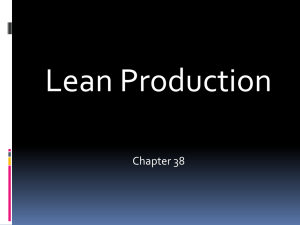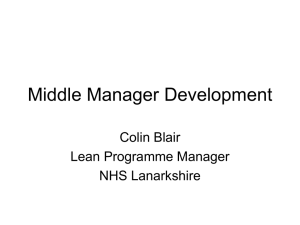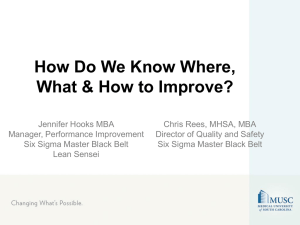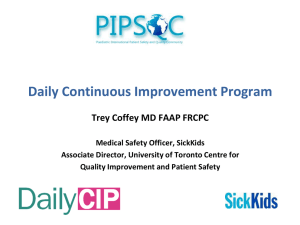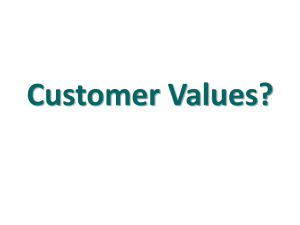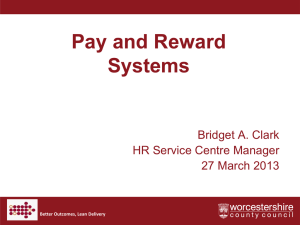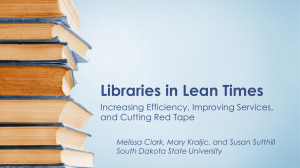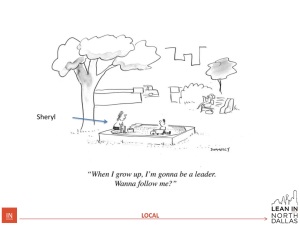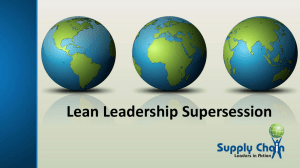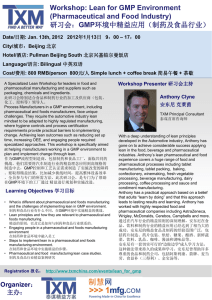5-MGB_LIPS_Presentation_20130919
advertisement
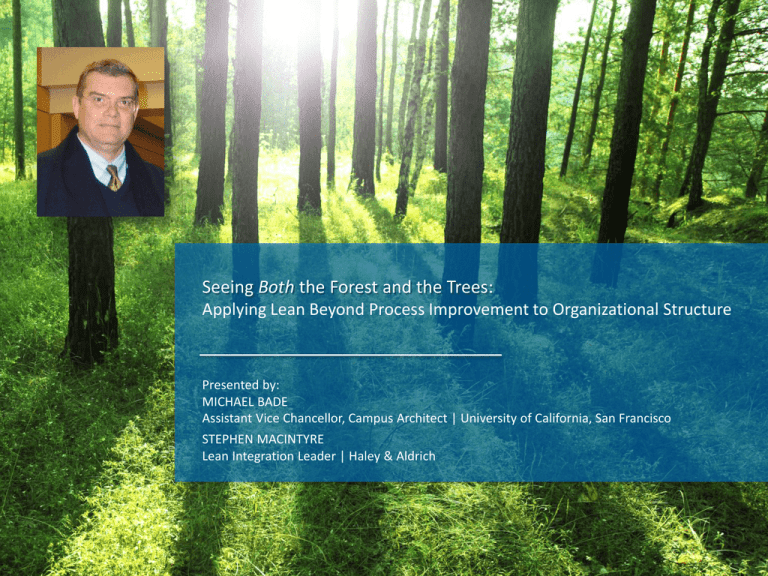
Seeing Both the Forest and the Trees: Applying Lean Beyond Process Improvement to Organizational Structure Presented by: MICHAEL BADE Assistant Vice Chancellor, Campus Architect | University of California, San Francisco STEPHEN MACINTYRE Lean Integration Leader | Haley & Aldrich DESIRED OUTCOMES • Understand how Lean Principles support organization design • See how customers and staff can play a big role in organization design (and affect your results) • Understand how to use Lean process change for short-term gains while building an organization structure and staff capability for long-term results AGENDA Situation • Where are we on our Lean Journey? Lean & Organization Design • Principles – how they fit Current Situation & Gaps • Customer and staff input • Skills we have; skills we need • Processes and their limitations Desired Outcomes • What do we want to achieve? Our Plan AGENDA Your Situation • Where are you on your Lean Journey? Lean & Organization Design • Principles – how they fit Current Situation & Gaps • Customer and staff input • Skills we have; skills we need • Processes and their limitations Desired Outcomes • What do we want to achieve? Our Plan WHAT IS LEAN? A system of thinking and acting which: Value Reduces Waste Respects People Increases Not an end in itself; it’s a way of achieving the results. Creates ability of people to adapt. GETTING STARTED On a Broader Lean Perspective Misconceptions We don’t have enough people with the right skills Our customers don’t understand Employees are dedicated and valuable We pay for strong, reliable performance We listen to our employees (but really listen to others) We continually create value We know who the big problems are Lean Perspectives We have not made a strong effort to simplify, standardize and error-proof We aren’t really solving customer problems Our processes help waste employee’s time & cause stress Poor performance is often hidden by heroics Employees have answers that need to be unleashed We’re all busy but only some of it really adds value Our systems are set up to give us exactly what we get WHAT IS ORGANIZATION DESIGN? • Deliberate method to configure structures, processes, rewards, and people to create an effective organization capable of achieving strategy. • Not an end in itself; it’s a way of achieving results. • Improves ability of organization to adapt. VICE CHANCELLOR ASSISTANT DIRECTOR 1 DIRECTOR 2 DIRECTOR 3 LEAN SYSTEM HAS “4P” PRINCIPLES EXPOSE & SOLVE PROBLEMS DEVELOP PEOPLE & PARTNERS RIGHT PROCESS RIGHT RESULTS LONG TERM PHILOSOPHY OVERARCHING LEAN PRNCIPLES – 4P Many Lean efforts focus on process “waste”. EXPOSE & This works but can be tough to SOLVE make stick without constant PROBLEMS involvement of lean practitioners or management. DEVELOP PEOPLE & PARTNERS RIGHT PROCESS RIGHT RESULTS LONG TERM PHILOSOPHY ORGANIZATION DESIGN Deals with Similar Considerations VICE CHANCELLOR ASSISTANT DIRECTOR 1 DIRECTOR 2 DIRECTOR 3 STRUCTURE Many organization design efforts focus on structure. This can be tough to make work without the right people, processes and strategy PEOPLE CAPABILITIES & REWARDS MANAGEMENT & WORK PROCESSES STRATEGY CONNECTED TO CUSTOMER NEEDS According to Susan Mohrman & others at USC’s Center for Effective Organizations High performing organizations support strategy with: Structure for performance & decisions Clear responsibilities & decision-making Skills & knowledge to operate without day-to-day high-level management control Integration with interdependent units Whole work processes that deliver value to the customer Measuring, responding to and learning from process & results Continually improving APPLY PRINCIPLES TO ORGANIZATION: STRATEGY & CUSTOMERS Assess customer needs, get honest feedback on performance. Build this into strategy. PROCESS Find out which processes are causing problems and work on them for your customers. (Measure) PEOPLE & PARTNERS Understand and match people’s drives and skills with customers and processes. STRUCTURE & MGMT PROCESS Identify how structure can help or impede what you need to achieve. Measure, implement, check with customers. AGENDA Your Situation • Where are we on our Lean Journey? Lean & Organization Design • Principles – how they fit Current Situation & Gaps • Customer and staff input • Skills we have; skills we need • Processes and their limitations Desired Outcomes • What do we want to achieve? Our Plan CURRENT SITUATION SUMMARY Customers satisfied with staff & projects Directors and staff go the extra distance Customers experience inconsistency & higher cost CP staff are stressed by complex processes CUSTOMERS: CURRENT STATE PAIN (H High, M Medium, L Low) (10 min.) Diabetes PAIN (H High, M Medium, L Low) (10 min.) FAS/Sr. Education/ Med- Adm. Pharmacy VC/Financ OM Med Research Education e SFGH CP Accountability & Responsibility ITS Deans Office HDF CCC Finance SC Facilities Mngmt. 1. Project Initiation Workload Allocation Project Delivery Strategy Project Initiation Project Launch Lots of Pain Need to be included in MEP basis of design & budget Project Forecasting Budget Development Project Launch Need to be included in MEP basis of design & budget Funding Request Risk Management Reporting 2. Design Professional Services Department Budget Worksheet Development Additional Funding Request Design Review & Permitting Insufficient stakeholder input into V.E. decisions Technology Selection Need to stay in communication on design changes at each phase of design development Strengths Capital Project Approval Payment Management 3. Construction Contractor Selection Invitation to Bid Prequal. 1st & 2nd Stages Change Management Numerous delays in project prior to start of construction Need to review change orders & submittals Construction Oversight Reporting 4. Occupancy Mgmt.. Training Training Post occupancy issues slow or incompletely resolved Support for remaining issues State Fire Marshall Need smoother turnover, warranty mgmt. punch list completion timing expectation communication Lots of Pain Technology Handoffs 5. Project Closeout Request for Notice of Completion & Final Closeout Archives Financial Closeout 6. Capital Planning Process Support Punch List Time Time PM often moves on to next project before all issues with current project are resolved Budget & Resources STAFF “PAIN” RESULTED FROM PROCESS, PERSONALITY, STRUCTURE • Workload Allocation • "Project Initiation" • Professional Services Procurement • Design Review & Permitting • Capital Project Approval • Contractor Selection • Change Management • Reporting • Occupancy Management • Archiving THINGS WORKING WELL Customers Staff & Directors • Excellent architects & designers. Several strong PMs and analysts. • Strong knowledge on team, always someone who can help • Many great projects provide the desired outcomes • Timely, transparent communications • Construction is well managed • Able to conceptualize and complete complex projects. • Everyone chips in – staff get along well • Highly skilled analysts provide good PM support THINGS WE NEED TO IMPROVE Customers Staff & Directors • Inconsistent quality by PMs • Lack consistency in PM methodologies • Close out 2+ yrs & hold funds • Too much waiting • Too costly, unrealistic budgets • CP is understaffed • Many processes “get in the way” e.g. closeout • Approval bottlenecks • Complex processes used for both small & large projects adds cost • Staff absorb hours to get job done PRIMARY CAUSES OF CURRENT CONDITION STRATEGY & CUSTOMERS WORK PROCESS PEOPLE & REWARDS Not standardized Need better ways to “hear” & quickly respond to customers Metrics are lagging & difficult to respond to Complexity & approvals consume time and budget Lack an effective business system Mix of staff capabilities & management drives could be improved STRUCTURE & MANAGEMENT PROCESS Lack role & responsibility clarity CP mgmt. structure gaps (inconsistency & decision-making speed) AVC/Campus Architect overburden WHAT STEPS ARE WE TAKING? STRATEGY & CUSTOMERS PROCESS PEOPLE & PARTNERS STRUCTURE & MGMT PROCESS CPAG (Customer) feedback session Training PI & Mgt Drives Evaluation Assess process needs Define Org Design Criteria to fill people, process and customer gaps Staff capabilities assessment Look at process, people problems Match staff makeup gaps with process & customer needs Identify & evaluate structure options Connect Pain & Positive Performance to Processes Ask customers which structure options they prefer Assess Customers & Value Test Process vs. Value & Staff experience using RACI/ Pain chart Kaizen and VSM Customer input CUSTOMER “PAIN” & STAFF PERSONALITY DRIVES MATCHED! Communication & Consultation Gaps Clear Structure & Standard Procedures Strengths Big Picture Thinking/Strategy Achieving CostEffective Results Speed & Decisiveness Mutual Trust WHAT DOES THIS MEAN FOR ACTIONS? Causes Helped Specify Org Design Criteria • Understanding customer needs and relationships provides design basis for processes • Better work processes will enable staff to be more effective, projects more cost-effective • People with the right skills will develop/implement better processes • Structure can speed up decisions, processes, resolve problems and distribute work SUMMARY OF KEY ACTIONS Process, Capabilities, Structure Will Improve Together 2013 Apr-Jun Action 2013 Jul-Sep 2013 Oct-Dec WORK & MANAGEMENT PROCESSES Prioritize & develop A3 plan Process improvement, metrics & business system STRUCTURE & CAPACITY Revisit structure & fill open roles Re-define AD Role – customer/project facing Work with other departments to delineate roles PEOPLE & SKILLS PM Skill Improvement Continual Improvement Skills 2014 Jan-Mar 2013-2014 Apr-Jun 2014-5 Small Projects Initiative • Small projects are weighted down with costs and the same process steps in letting contracts as large projects • On the other hand, customers want speedy implementation, low cost, and low disruption of their operations • Small projects use small contractors who cannot invest in process improvements like larger contractors can • Most projects are small – UCSF typically has ~200 projects ongoing, of which all but a handful are small • Dollar volume of small projects can reach $100M annually Strategies • Use Best Value contractor selection to identify highcapability, high-quality contractors • Redesign small projects implementation process – use Job Order Contracting (JOC) to batch small projects into larger batches • Use Best Value to select contractors for mediumsized projects using Design-Bid-Build delivery • Create standardized work processes internally to allow process benchmarking • Focus improvement program on customer value Small Projects Process Improvements • Batching small projects gives scale which allows use of Lean construction tools such as Last Planner, Pull Scheduling • Design of small projects system can allow pairing of design and construction firms into a virtual designbuild team • Duration of JOC contract allows contractor to work with UCSF to improve project logistics and support services (from Facilities Management and other units) • More to come! LEAN APPROACH GAVE US A PLAN: Improve Each Element For Higher Performance 1. Strategy: continual PDCA of customer needs, transparency, new business system, define department roles 2. Work & Management Processes: systematically streamline, improve delivery models, support with business system 3. People: Hire to fill the gaps in capabilities & drives, improve capacity with process change 4. Structure: Reshape reporting relationships A Few Lessons Learned • Start with a shared understanding of the goals, current situation and problems; if you don’t focus on what is most important you might improve the wrong things • Get the right people involved – include policy and decision makers, staff, customers, suppliers - challenge all of them and help them improve. Select an implementation leader. • Trust people doing the work to understand WAH (What Actually Happens) and to develop solutions; look for waste AND for positive deviants • Match structure to processes to resources to customer needs to strategy • Engage people to understand the big picture; they will develop ownership for long term success REFLECTION • Questions • Plus/Delta

